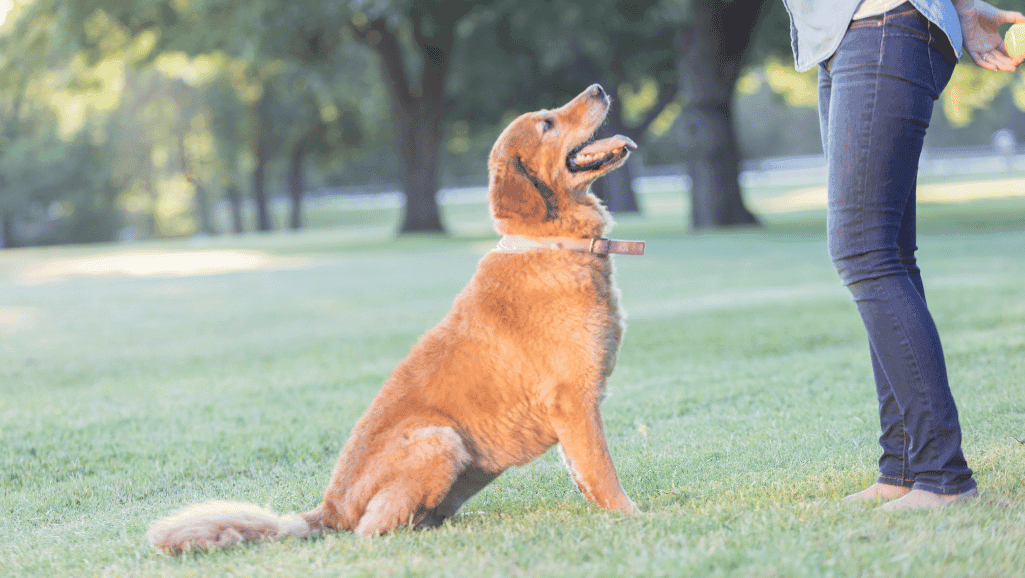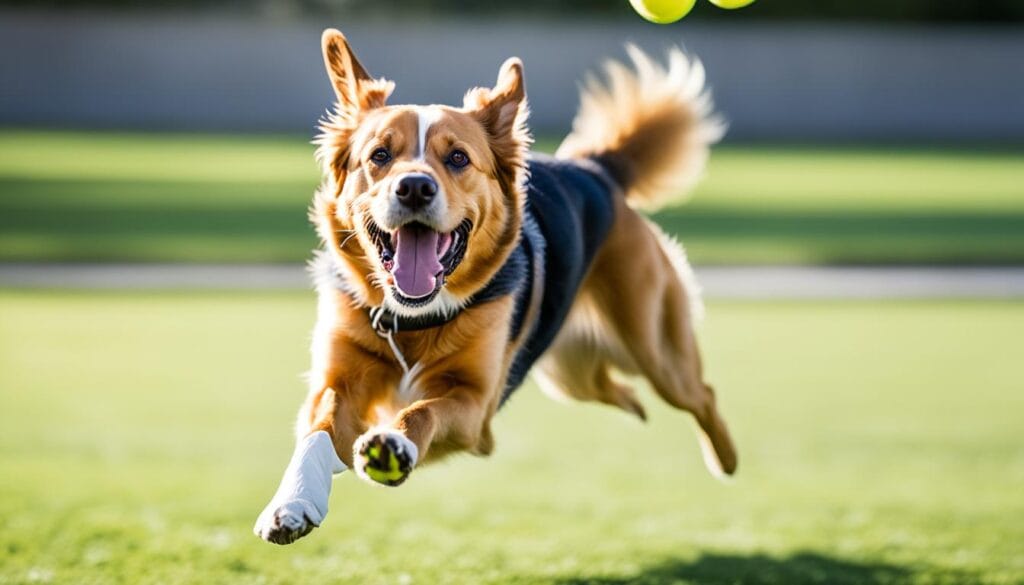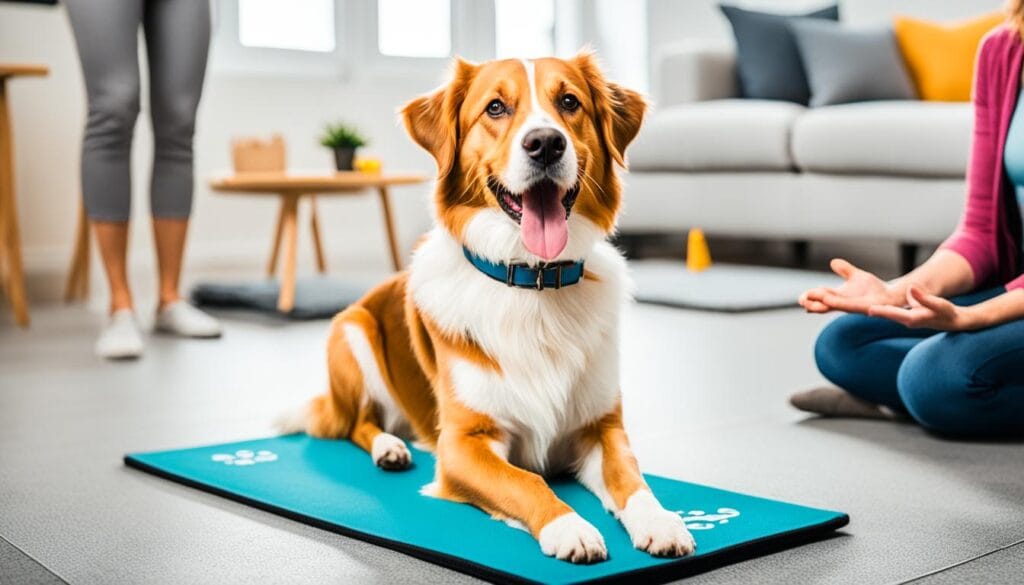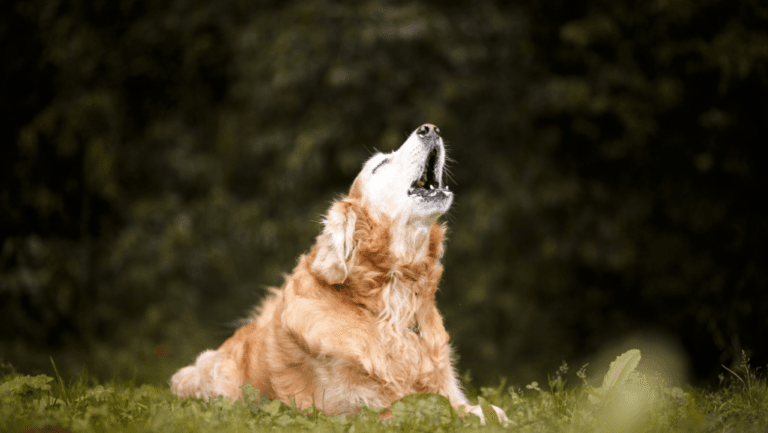Having a good relationship with dogs depends on good dog behavior training. Training helps solve dog behavior problems and makes behavioral issues in pets less common. Since 57% of dogs aged 6 months to 2 years need behavior help, training is very important. Being consistent helps dogs understand and follow what their owners say.
How long and how well you interact with your dog matters a lot for training. Experts suggest training sessions should be short and keep the dog’s full attention. These sessions should last about 20 minutes. Using positive methods like treats and praise can make dogs happier and more obedient. Almost all vets say positive reinforcement works best for training. Getting advice from professional trainers can really help with tough behavioral issues in pets.
Key Takeaways
- Young dogs are crucial candidates for behavior and training, with early intervention promising better outcomes.
- Consistency in commands and rewards is key to successful dog training.
- Short, focused training sessions lead to increased engagement and learning.
- Positive reinforcement is the most recommended approach by veterinarians for nurturing happy pets.
- Seeking the guidance of professional dog trainers can provide tailored solutions for dog behavior problems.
- A distraction-free environment enhances a dog’s ability to learn during training.
- Starting training during puppyhood sets the stage for a well-behaved adult dog.
Understanding Positive Reinforcement Training
Positive reinforcement training is key in modern dog training. It focuses on making good behavior better without hurting the dog’s feelings. This method uses behavior modification techniques to teach obedience and build trust between dogs and owners. It makes learning fun and effective.
The Principles of Positive Reinforcement
Positive reinforcement is based on operant conditioning. It rewards a behavior to encourage it. Rewards should be given right after the desired action to link the behavior with the reward clearly.
This method works well for basic commands like sit, stay, and heel. These commands are important for everyday life with pets.
Implementing Immediate Rewards
Rewards must come right after the desired behavior. This helps the dog connect the action with the reward. Using treats, praise, or a quick play session as rewards makes training more effective.
This approach helps dogs learn faster and stick to the new behavior better.
Benefits of Using Treats and Toys as Incentives
Treats and toys are crucial in positive reinforcement training. They should be something the dog really wants, making training fun and productive. Small, tasty treats keep dogs focused, while toys provide physical and emotional fun.
This makes training more enjoyable for dogs. Seeing their happiness when they get rewards makes them more eager to learn and cooperate.
Positive reinforcement does more than teach obedience. It makes dogs active learners, boosting their thinking and feelings. It turns pets into confident, stress-free animals eager to learn and interact well with their world.
For more on this effective training method, check out PetMD for tips and advice.
The Importance of Timing and Consistency
When exploring effective training methods and dog training techniques, it’s key to focus on timing in training and consistent dog training. These elements are vital for creating a well-behaved pet. Giving rewards at the right time and using consistent cues helps dogs learn better and follow commands more.
Timing is crucial because it links the behavior to the reward or correction. For example, give a reward right after the desired action. Waiting too long can confuse the dog about what action is being rewarded. This is a key part of dog training techniques that depends on quick reactions during training.
Consistent dog training means everyone uses the same commands and rewards. If commands or rewards change, it confuses the dog and slows down training. It’s not just about repeating things; it’s about making a predictable learning environment. Dogs should learn consistently in training and daily life.
- Maintaining consistent verbal cues and rewards
- Every family member following the same training protocols
- Creating a consistent daily routine for training repetitions
Slowly add these effective training methods to your training plan and see big changes in your dog’s behavior. These simple ideas—timing and consistency—are what make a dog well-trained. By using these methods carefully, trainers can build a strong connection with their dogs. This connection is key for successful training.
Behavior and Training: Building the Foundation
Starting with behavior and training means learning key skills first. Skills like ‘Sit’, ‘Stay’, ‘Come’, and ‘Down’ are vital. They help you and your pet talk better. These skills are important for dogs of all ages and breeds.
They help with many behavioral therapies for pets.
Choosing Effective Verbal Cues
Choosing clear and simple verbal cues is key for good dog behavior. Using these cues consistently helps avoid confusion or frustration in your dog.
Maintaining Consistency Across Training Sessions
Keeping training consistent in different places is important. Use the same cues in the park, at home, or with distractions. This helps your pet learn better and builds trust.
When to Employ Positive Reinforcement Techniques
Positive reinforcement is a top choice for training. Rewarding good behavior helps your dog remember it. It’s key for teaching new behaviors or improving old ones.
| Resource | Type | Price |
|---|---|---|
| Canine Body Language | Book | $49.95 |
| Get Connected with Your Dog | Book | $49.95 |
| Brenda Aloff’s Fundamentals | DVD | $34.95 |
| Puppy Problems? No Problem! | Book | $39.95 |
| Aggression in Dogs | Book | $49.95 |
Shaping Behavior with Incremental Steps
Shaping behavior is key in training animals. It breaks down hard commands into easy steps. This helps dogs learn by rewarding each step, building their confidence and skills.
Using shaping in behavior modification helps dogs learn step by step. It makes training easy and supports their learning pace. It also meets their unique needs.
From Basic Obedience to Complex Commands
Trainers start with simple commands like ‘sit’ or ‘stay’. Then, they use shaping to move on to harder commands. They reward small achievements to keep the dog motivated.
For example, teaching ‘shake hands’ starts with lifting a paw. Then, the goal is to get the full action. This builds a strong base for learning more.
Using Shaping to Teach New Tricks
Shaping helps dogs learn new tricks by rewarding each step. For a trick like ‘roll over’, start with ‘lie down’, then ‘turn on the side’, and finally ‘roll’. This makes learning clear and effective.
Shaping boosts a dog’s excitement and deepens their understanding of commands. It makes them more responsive and agile. It changes how they behave, making them more active and engaged.
Shaping fits different dogs’ learning styles and needs. It makes training more effective and lasting. By adapting to each dog, trainers can create a better training plan.
In conclusion, shaping is vital in animal training. It makes learning easy and helps dogs do complex tasks well. By rewarding progress, trainers can make training successful and fun for dogs.
Creating a Diverse Reward System
To keep animals motivated in pet obedience classes, a diverse reward system is key. It’s not just about changing treats. It’s about using different ways to reward pets based on what they like and need. This keeps pets interested and active in their training.
Experts in behaviorist services suggest using both treats and praise. For example, treats work well, but adding praise or more playtime makes training better. This keeps pets excited by food and builds a strong bond with their trainers or owners.
- Small, tasty treats make training fun during pet obedience classes.
- Changing the type of treats often keeps pets interested and not bored with the same old rewards.
- Things like praise, gentle petting, or short play with a favorite toy are important too. They help pets learn good behaviors.
Also, using a randomized reward schedule can really help. It makes training more exciting and challenging for pets. They never know when they’ll get a reward, which keeps them on their toes.
As noted in “Drive: The Surprising Truth About What Motivates Us” by Daniel Pink, unexpected rewards can produce a stronger and more lasting behavioral change than predictable, contingent rewards.
The main aim of a diverse reward system is more than just teaching obedience. It’s about building a strong, respectful relationship between pets and owners. It’s about making a learning space where pets want to join in and feel celebrated for their efforts. This keeps them keen and excited about learning.
Transitioning From Continuous to Intermittent Reinforcement
Understanding the difference between continuous and intermittent reinforcement is key in behavioral modification. At first, continuous reinforcement is vital, rewarding every desired behavior. This method is great for the early stages of learning, making the behavior stick.
As learning grows, moving to intermittent reinforcement is crucial. This method rewards behavior less often, making it harder for the behavior to stop. There are different types like fixed-ratio, variable-ratio, fixed-interval, and variable-interval, each affecting behavior in unique ways.
| Type of Schedule | Characteristics | Behavioral Impact |
|---|---|---|
| Fixed-Ratio | Reinforcement after a set number of responses | High, steady response rate |
| Variable-Ratio | Reinforcement after an unpredictable number of responses | High, consistent performance with less predictability |
| Fixed-Interval | Reinforcement after a specified time has elapsed | Increased responses as the time for reinforcement approaches |
| Variable-Interval | Reinforcement at varying time intervals | Slow, steady rate of response, less susceptibility to extinction |
These behavior management techniques make for more realistic and lasting changes. They work well in schools, therapy, or training. Knowing how to use these reinforcement methods can make behavior change programs more effective.
Switching from continuous to intermittent reinforcement helps keep the desired behavior going with fewer rewards. This approach saves resources and is more like real life, where rewards aren’t always given but behaviors should still last. Reinforcement strategies like these help behaviors stick over time, making behavioral change successful.
Maximizing the Impact of Puppy Training
Starting puppy training is exciting and important for both puppies and their owners. It helps build good habits and strengthens the bond between the puppy and its family. Using puppy training classes and clicker training for dogs is crucial for success.
Knowing how puppies grow is key to training them well. The first three months are very important. They shape a puppy’s future behavior and personality. Meeting lots of people and experiencing new things helps puppies grow confident and social.
Starting Early: The Optimal Age for Training
Puppies are most open to learning between 6 months and 2 years old. But, teaching them basic commands and socialization from a few weeks old is best. Breeders often start training early to make sure dogs are ready for homes.
Utilizing Treats and Clicker Training Effectively
Choosing the right treats is key in puppy training tips. They should be tasty and healthy to reward good behavior. Clicker training uses a clear signal to mark correct actions, helping dogs learn fast. It’s important to give treats right when the good behavior happens, so the puppy knows what it did right.
| Training Aspect | Technique | Benefit |
|---|---|---|
| Early Socialization | Exposure to diverse people and animals | Builds confidence and adaptability |
| Positive Reinforcement | High value treats, clicker signals | Encourages repetition of good behavior |
| Choice of Rewards | Use preferred treats based on task difficulty | Ensures engagement and effectivity |
| Reward Timing | Immediate reinforcement | Reduces confusion and strengthens associations |
Using these strategies in your puppy training tips boosts learning and strengthens your bond with your puppy. It sets the stage for a well-behaved and happy pet. Remember, be consistent, patient, and understand what each puppy needs and how they react to training.
Overcoming Common Behavioral Issues in Pets
Dealing with behavioral issues in pets is crucial for a peaceful home and happy pets. Issues like constant barking, chewing, and more need to be managed. Using dog behavior modification and canine behavior therapy can help solve these problems.
Dealing with Barking, Chewing, and Jumping
Behaviors like barking, chewing, and jumping often show deeper issues like anxiety or boredom. Training programs with habituation, desensitization, and counterconditioning can work well. For example, teaching your pet new behaviors with positive rewards can stop unwanted actions and encourage better ones.
How to Address Aggression in Dogs
For training aggressive dogs, a specific plan is key. It’s important to know why your dog is aggressive, like if it’s over things it values or because it’s scared of other dogs. Experts in canine behavior therapy can be very helpful, especially if regular training doesn’t work. They use advanced methods that are safe and effective.
Learning about why pets behave badly and how to train them helps fix problems for good. Whether it’s through positive rewards, special training, or expert advice, changing pet behaviors takes time, patience, and understanding.
Expert Strategies for Dog Socialization
Effective dog socialization is more than just exposing your pet to new things. It’s about using smart socialization strategies with help from an animal behavior consultant. Knowing a key fact is crucial: Proper socialization can cut down behavioral issues in dogs by up to 70%.
Experts say the best time for a puppy to learn social skills is from 3 to 16 weeks old. During this time, puppies are open to new things, which affects their social behavior later. It’s best to introduce young dogs to different places, people, and animals slowly, making sure each meeting is good and safe. Behavior counseling for pets can help fill in any missing pieces, giving special advice for better results.
Here are some key points on why structured socialization and expert advice matter:
- 90% of dog trainers say to adjust your expectations when socializing young puppies, keeping in mind their growth stage.
- About 95% of dog behavior experts say positive reinforcement is key to encouraging good behavior in social situations.
- 85% of dog experts think a positive attitude from the owner greatly helps in successful training and better social skills in dogs.
With these facts, using socialization strategies from an animal behavior specialist is very helpful. Good dog socialization is about giving your dog a wide range of positive experiences. Using treats and praise, as 82% of trainers suggest, can really help. Also, getting advice from an animal behavior consultant or joining puppy social classes is key for your dog’s behavior to grow well.
Working with an animal behavior specialist for behavior counseling for pets makes sure any issues are tackled right. This helps improve your pet’s overall happiness and how well they get along with others.
Conclusion
The journey of understanding dog behavior and training is key to building a strong bond with our dogs. It helps them become well-adjusted and happy family members. Using positive reinforcement training is like teaching in schools. It rewards good behavior, making kids more active and complete tasks, especially in young ones.
Working with a professional dog trainer or joining good dog training programs can really help. These trainers are like skilled teachers who know that focusing too much on bad behavior can hurt the learning process. It can lead to more negative interactions, which is bad for kids and dogs alike.
By using strategies from both dog training and education, we can improve how we train dogs. It’s not about fixing a pet; it’s about understanding and supporting them. Staying objective helps us make better training plans. This way, our dogs get the care and guidance they need to be happy family members.
Let’s celebrate the positive changes we see in training and keep building strong bonds with our dogs.




















